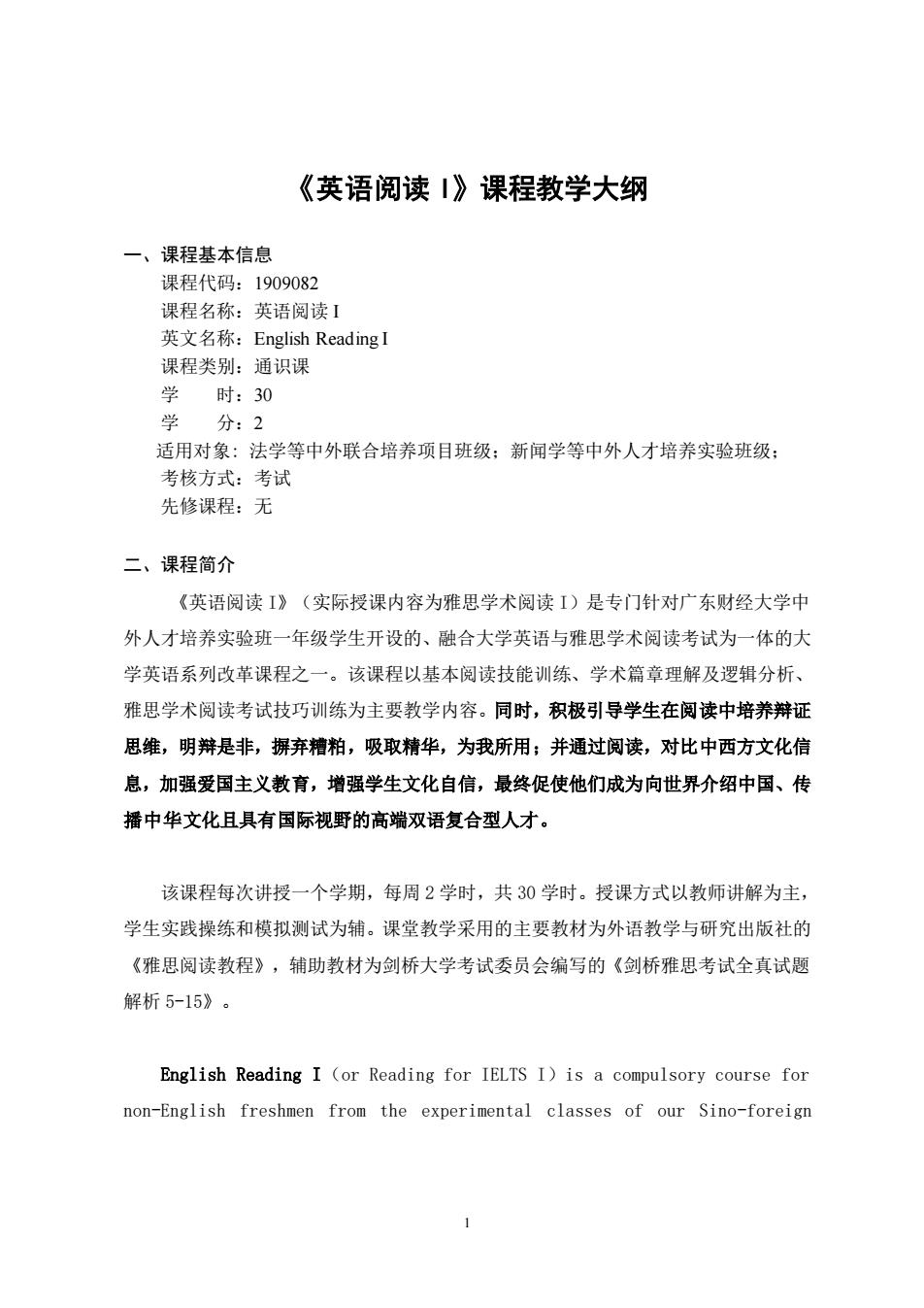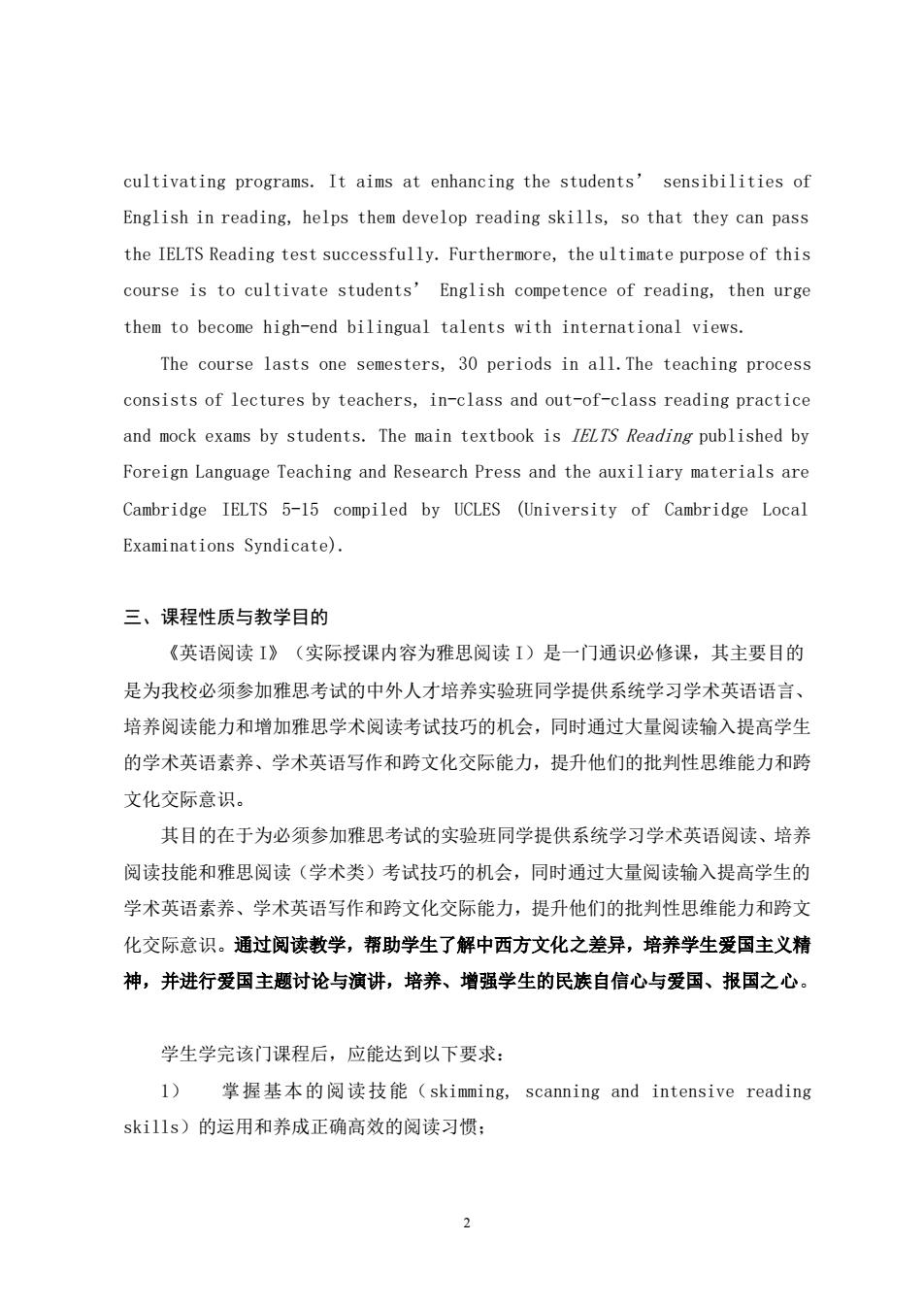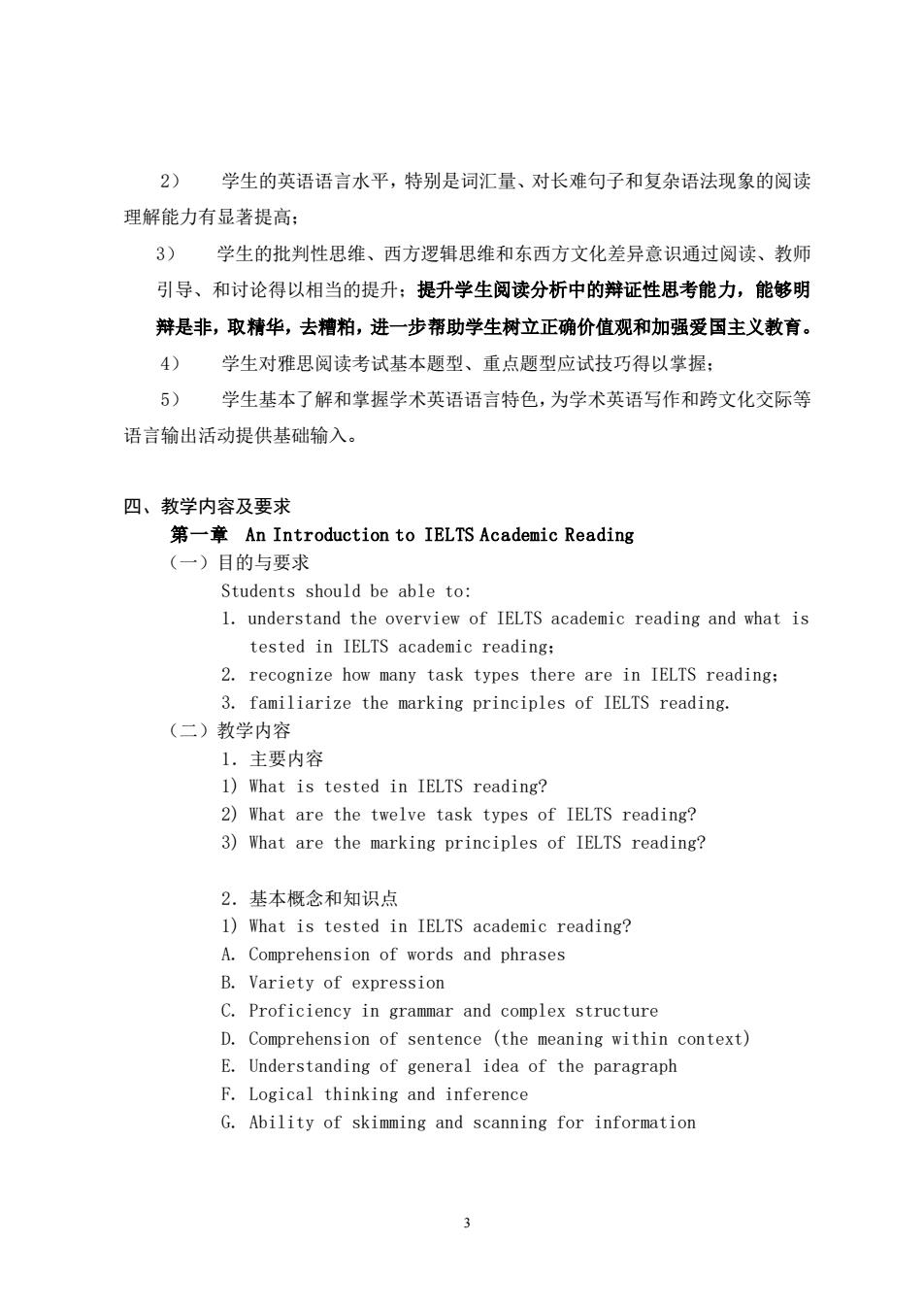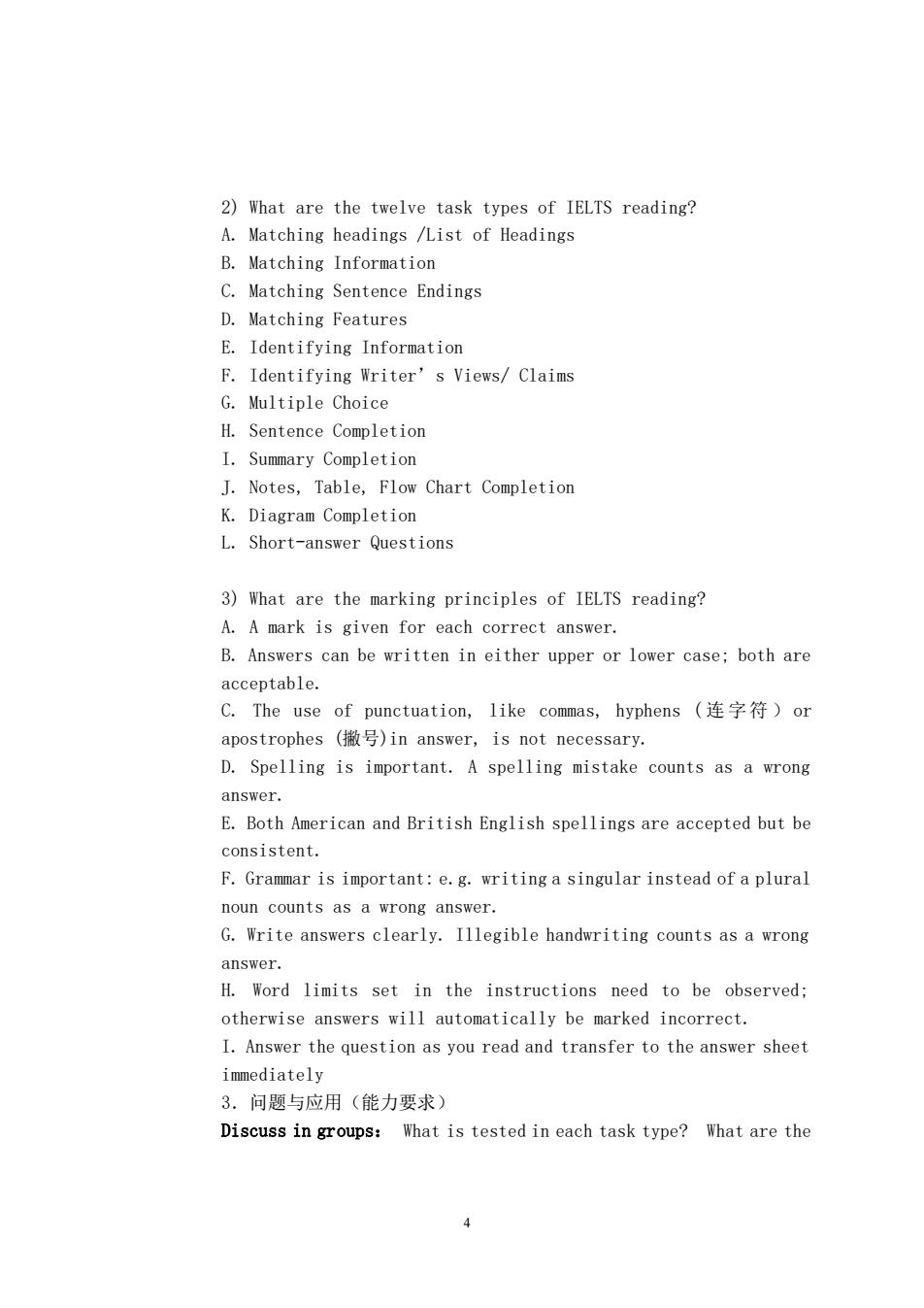
《英语阅读1》课程教学大纲 一、课程基本信息 课程代码:1909082 课程名称:英语阅读1 英文名称:English Reading 课程类别:通识课 学时:30 学分:2 适用对象:法学等中外联合培养项目班级:新闻学等中外人才培养实验班级: 考核方式:考试 先修课程:无 二、课程简介 《英语阅读I》(实际授课内容为雅思学术阅读I)是专门针对广东财经大学中 外人才培养实验班一年级学生开设的、融合大学英语与雅思学术阅读考试为一体的大 学英语系列改革课程之一。该课程以基本阅读技能训练、学术篇章理解及逻辑分析、 雅思学术阅读考试技巧训练为主要教学内容。同时,积极引导学生在阅读中培养辩证 思维,明辩是非,摒弃糟粕,吸取精华,为我所用;并通过阅读,对比中西方文化信 息,加强爱国主义教育,增强学生文化自信,最终促使他们成为向世界介绍中国、传 播中华文化且具有国际视野的高端双语复合型人才。 该课程每次讲授一个学期,每周2学时,共30学时。授课方式以教师讲解为主, 学生实践操练和模拟测试为辅。课堂教学采用的主要教材为外语教学与研究出版社的 《雅思阅读教程》,辅助教材为剑桥大学考试委员会编写的《剑桥雅思考试全真试题 解析5-15》。 English Reading I (or Reading for IELTS I)is a compulsory course for non-English freshmen from the experimental classes of our Sino-foreign
1 《英语阅读 I》课程教学大纲 一、课程基本信息 课程代码:1909082 课程名称:英语阅读 I 英文名称:English Reading I 课程类别:通识课 学 时:30 学 分:2 适用对象: 法学等中外联合培养项目班级;新闻学等中外人才培养实验班级; 考核方式:考试 先修课程:无 二、课程简介 《英语阅读 I》(实际授课内容为雅思学术阅读 I)是专门针对广东财经大学中 外人才培养实验班一年级学生开设的、融合大学英语与雅思学术阅读考试为一体的大 学英语系列改革课程之一。该课程以基本阅读技能训练、学术篇章理解及逻辑分析、 雅思学术阅读考试技巧训练为主要教学内容。同时,积极引导学生在阅读中培养辩证 思维,明辩是非,摒弃糟粕,吸取精华,为我所用;并通过阅读,对比中西方文化信 息,加强爱国主义教育,增强学生文化自信,最终促使他们成为向世界介绍中国、传 播中华文化且具有国际视野的高端双语复合型人才。 该课程每次讲授一个学期,每周 2 学时,共 30 学时。授课方式以教师讲解为主, 学生实践操练和模拟测试为辅。课堂教学采用的主要教材为外语教学与研究出版社的 《雅思阅读教程》,辅助教材为剑桥大学考试委员会编写的《剑桥雅思考试全真试题 解析 5-15》。 English Reading I(or Reading for IELTS I)is a compulsory course for non-English freshmen from the experimental classes of our Sino-foreign

cultivating programs.It aims at enhancing the students'sensibilities of English in reading,helps them develop reading skills,so that they can pass the IELTS Reading test successfully.Furthermore,the ultimate purpose of this course is to cultivate students'English competence of reading,then urge them to become high-end bilingual talents with international views. The course lasts one semesters,30 periods in all.The teaching process consists of lectures by teachers,in-class and out-of-class reading practice and mock exams by students.The main textbook is IELTS Reading published by Foreign Language Teaching and Research Press and the auxiliary materials are Cambridge IELTS 5-15 compiled by UCLES (University of Cambridge Local Examinations Syndicate). 三、课程性质与教学目的 《英语阅读I》(实际授课内容为雅思阅读)是一门通识必修课,其主要目的 是为我校必须参加雅思考试的中外人才培养实验班同学提供系统学习学术英语语言、 培养阅读能力和增加雅思学术阅读考试技巧的机会,同时通过大量阅读输入提高学生 的学术英语素养、学术英语写作和跨文化交际能力,提升他们的批判性思维能力和跨 文化交际意识。 其目的在于为必须参加雅思考试的实验班同学提供系统学习学术英语阅读、培养 阅读技能和雅思阅读(学术类)考试技巧的机会,同时通过大量阅读输入提高学生的 学术英语素养、学术英语写作和跨文化交际能力,提升他们的批判性思维能力和跨文 化交际意识。通过阅读教学,帮助学生了解中西方文化之差异,培养学生爱国主义精 神,并进行爱国主题讨论与演讲,培养、增强学生的民族自信心与爱国、报国之心。 学生学完该门课程后,应能达到以下要求: I)掌握基本的阅读技能(skimming,scanning and intensive reading ski11s)的运用和养成正确高效的阅读习惯: 2
2 cultivating programs. It aims at enhancing the students’ sensibilities of English in reading, helps them develop reading skills, so that they can pass the IELTS Reading test successfully. Furthermore, the ultimate purpose of this course is to cultivate students’ English competence of reading, then urge them to become high-end bilingual talents with international views. The course lasts one semesters, 30 periods in all.The teaching process consists of lectures by teachers, in-class and out-of-class reading practice and mock exams by students. The main textbook is IELTS Reading published by Foreign Language Teaching and Research Press and the auxiliary materials are Cambridge IELTS 5-15 compiled by UCLES (University of Cambridge Local Examinations Syndicate). 三、课程性质与教学目的 《英语阅读 I》(实际授课内容为雅思阅读 I)是一门通识必修课,其主要目的 是为我校必须参加雅思考试的中外人才培养实验班同学提供系统学习学术英语语言、 培养阅读能力和增加雅思学术阅读考试技巧的机会,同时通过大量阅读输入提高学生 的学术英语素养、学术英语写作和跨文化交际能力,提升他们的批判性思维能力和跨 文化交际意识。 其目的在于为必须参加雅思考试的实验班同学提供系统学习学术英语阅读、培养 阅读技能和雅思阅读(学术类)考试技巧的机会,同时通过大量阅读输入提高学生的 学术英语素养、学术英语写作和跨文化交际能力,提升他们的批判性思维能力和跨文 化交际意识。通过阅读教学,帮助学生了解中西方文化之差异,培养学生爱国主义精 神,并进行爱国主题讨论与演讲,培养、增强学生的民族自信心与爱国、报国之心。 学生学完该门课程后,应能达到以下要求: 1) 掌握基本的阅读技能(skimming, scanning and intensive reading skills)的运用和养成正确高效的阅读习惯;

2)学生的英语语言水平,特别是词汇量、对长难句子和复杂语法现象的阅读 理解能力有显著提高 3) 学生的批判性思维、西方逻辑思维和东西方文化差异意识通过阅读、教师 引导、和讨论得以相当的提升:提升学生阅读分析中的辩证性思考能力,能够明 辩是非,取精华,去糟粕,进一步帮助学生树立正确价值观和加强爱国主义教育。 4)学生对雅思阅读考试基本题型、重点题型应试技巧得以掌握: 5) 学生基本了解和掌握学术英语语言特色,为学术英语写作和跨文化交际等 语言输出活动提供基础输入。 四、教学内容及要求 第一章An Introduction to IELTS Academic Reading (一)目的与要求 Students should be able to: 1.understand the overview of IELTS academic reading and what is tested in IELTS academic reading: 2.recognize how many task types there are in IELTS reading: 3.familiarize the marking principles of IELTS reading. (二)教学内容 1.主要内容 1)What is tested in IELTS reading? 2)What are the twelve task types of IELTS reading? 3)What are the marking principles of IELTS reading? 2.基本概念和知识点 1)What is tested in IELTS academic reading? A.Comprehension of words and phrases B.Variety of expression C.Proficiency in grammar and complex structure D.Comprehension of sentence (the meaning within context) E.Understanding of general idea of the paragraph F.Logical thinking and inference G.Ability of skimming and scanning for information 3
3 2) 学生的英语语言水平,特别是词汇量、对长难句子和复杂语法现象的阅读 理解能力有显著提高; 3) 学生的批判性思维、西方逻辑思维和东西方文化差异意识通过阅读、教师 引导、和讨论得以相当的提升;提升学生阅读分析中的辩证性思考能力,能够明 辩是非,取精华,去糟粕,进一步帮助学生树立正确价值观和加强爱国主义教育。 4) 学生对雅思阅读考试基本题型、重点题型应试技巧得以掌握; 5) 学生基本了解和掌握学术英语语言特色,为学术英语写作和跨文化交际等 语言输出活动提供基础输入。 四、教学内容及要求 第一章 An Introduction to IELTS Academic Reading (一)目的与要求 Students should be able to: 1. understand the overview of IELTS academic reading and what is tested in IELTS academic reading; 2. recognize how many task types there are in IELTS reading; 3. familiarize the marking principles of IELTS reading. (二)教学内容 1.主要内容 1) What is tested in IELTS reading? 2) What are the twelve task types of IELTS reading? 3) What are the marking principles of IELTS reading? 2.基本概念和知识点 1) What is tested in IELTS academic reading? A. Comprehension of words and phrases B. Variety of expression C. Proficiency in grammar and complex structure D. Comprehension of sentence (the meaning within context) E. Understanding of general idea of the paragraph F. Logical thinking and inference G. Ability of skimming and scanning for information

2)What are the twelve task types of IELTS reading? A.Matching headings /List of Headings B.Matching Information C.Matching sentence endings D.Matching Features E.Identifying Information F.Identifying Writer's Views/Claims G.Multiple Choice H.Sentence Completion I.Summary Completion J.Notes,Table,Flow Chart Completion K.Diagram Completion L.Short-answer Questions 3)What are the marking principles of IELTS reading? A.A mark is given for each correct answer B.Answers can be written in either upper or lower case;both are acceptable. C.The use of punctuation,.like commas,.hyphens(连字符)or apostrophes(撤号)in answer,is not necessary. D.Spelling is important.A spelling mistake counts as a wrong answer e.Both american and british english spellings are accepted but be consistent F.Grammar is important:e.g.writing a singular instead of a plural noun counts as a wrong answer. G.Write answers clearly.Illegible handwriting counts as a wrong answer. H.Word limits set in the instructions need to be observed; otherwise answers will automatically be marked incorrect. I.Answer the question as you read and transfer to the answer sheet immediately 3.问题与应用(能力要求) Discuss in groups:What is tested in each task type?What are the 4
4 2) What are the twelve task types of IELTS reading? A. Matching headings /List of Headings B. Matching Information C. Matching Sentence Endings D. Matching Features E. Identifying Information F. Identifying Writer’s Views/ Claims G. Multiple Choice H. Sentence Completion I. Summary Completion J. Notes, Table, Flow Chart Completion K. Diagram Completion L. Short-answer Questions 3) What are the marking principles of IELTS reading? A. A mark is given for each correct answer. B. Answers can be written in either upper or lower case; both are acceptable. C. The use of punctuation, like commas, hyphens ( 连 字符 ) or apostrophes (撇号)in answer, is not necessary. D. Spelling is important. A spelling mistake counts as a wrong answer. E. Both American and British English spellings are accepted but be consistent. F. Grammar is important: e.g. writing a singular instead of a plural noun counts as a wrong answer. G. Write answers clearly. Illegible handwriting counts as a wrong answer. H. Word limits set in the instructions need to be observed; otherwise answers will automatically be marked incorrect. I. Answer the question as you read and transfer to the answer sheet immediately 3.问题与应用(能力要求) Discuss in groups: What is tested in each task type? What are the

marking principles of IELTS reading? (三)思考与实践 Discuss in groups:Watch the video program:"IELTS Reading Band Descriptor"and discuss the Descriptor with partners. (四)教学方法与手段 本章教学主要采用的方法和手段:课堂讲授、多媒体教学、团队合作、分 组讨论、课谭讨论。 第二章A Mock Test of IELTS Academic Reading (一)日的与要求 Students should be able to: 1.know how an IELTS Academic Reading is tested: 2.understand the overall strategies for IELTS Academic Reading: 3.master the rules that should be followed when filling in the answer sheet of IELTS reading. (二)教学内容 1.主要内容 1)A mock test of IELTS Academic Reading:1 hour 2)After the mock test,students are required to answer the question i.How do you think about the test?Which part is the most difficult one for you? A.Section 1 Passage 1,13 questions B.Section 2 =Passage 2,13 questions C.Section 3 Passage 3,14 questions Each section is a little more difficult than the one before and features authentic reading passages. ii.What rules should follow when filling in the answer sheet? A.American and british english spelling B.Word Limits C.Upper-case and lower-case 2.基本概念和知识点 1)American and British English spelling 2)Word Limits 3)Upper-case and lower-case letters 3.问题与应用(能力要求) 5
5 marking principles of IELTS reading? (三)思考与实践 Discuss in groups: Watch the video program : “IELTS Reading Band Descriptor”and discuss the Descriptor with partners. (四)教学方法与手段 本章教学主要采用的方法和手段: 课堂讲授、多媒体教学、团队合作、分 组讨论、课堂讨论。 第二章 A Mock Test of IELTS Academic Reading (一)目的与要求 Students should be able to: 1. know how an IELTS Academic Reading is tested; 2. understand the overall strategies for IELTS Academic Reading; 3. master the rules that should be followed when filling in the answer sheet of IELTS reading. (二)教学内容 1.主要内容 1) A mock test of IELTS Academic Reading: 1 hour 2) After the mock test, students are required to answer the question: i. How do you think about the test? Which part is the most difficult one for you? A. Section 1 = Passage 1, 13 questions B. Section 2 = Passage 2, 13 questions C. Section 3 = Passage 3, 14 questions Each section is a little more difficult than the one before and features authentic reading passages. ii. What rules should follow when filling in the answer sheet? A. American and British English spelling B. Word Limits C. Upper-case and lower-case 2. 基本概念和知识点 1) American and British English spelling 2) Word Limits 3) Upper-case and lower-case letters 3. 问题与应用(能力要求)